#aztec creation myth
Text
By chance I saw an account called Corazon Mexica post on Twitter about a Nahua myth about the creation of the sun. The myth goes that, at the beginning of time, the Teteo (gods) gathered at the city of Teotihuacan, and the two gods Nanahuatzin and Tecciztecatl were selected to sacrifice themselves by burning in a sacred fire in order to become the Sun. Nanahuatzin did so and indeed became the Sun, while Tecciztecatl, who initially failed to do so, followed Nanahuatzin out of jealousy and did become another Sun, but then his light was dimmed out by a rabbit that was thrown at his face and then he became the Moon instead.
It struck me when I saw it, because it felt something like what I was writing about on Saturday when talking about burning in fire in terms of destroying to become something else.
You can check it out here again:
Just feels like there's a conceptual similarity, and to me a fairly obvious one.
9 notes
·
View notes
Text
Sacrifice and Destruction: The Apocalyptic Aztec Creation Myths | Ancient Origins
https://www.ancient-origins.net/myths-legends-americas/aztec-creation-myths-0071
View On WordPress
#Aztec Pantheon#Aztecs#Chaac#Chalchiutlicue#Cipactli#Cocijo#Creation Myth#Five Suns#Four Jaguar#Four Movement#Four Rain#Four Water#Maya#Mesoamerican#Moon#Nahuatl#Nanahuatzin#Olmecs#Ometecuhtl#Ometecuhtli#Pan-Mesoamerican#Popol Vuh#Quetzalcoatl#Tecuciztecatl#Teotihuacan#Tezcatlipocal#Tlaloc#Toltecs#Tonacacihuatl#Tonacatecuhti
1 note
·
View note
Text
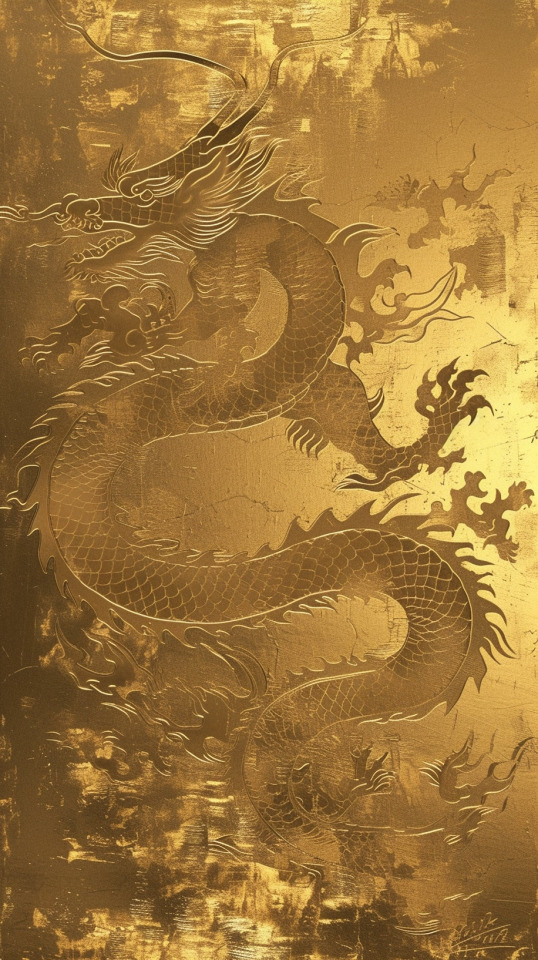
2024: Year of the Dragon and the Wisdom of the Dragon Spirit Animal
Creation & Cosmos
The dragon is a celestial symbol of life force and the power of manifestation, the primal waters or First Cause in countless civilizations across the globe. In Hindu beliefs the dragon is also associated with the First Cause and is said to produce soma, the elixir of immortality. Zu (or Asag), the Sumarian dragon who stole the Tablets of Law that maintained the order of the Universe from the great god Enlin and was subsequently killed by the Sun god Nintura to prevent the destruction of the universe is the oldest known legend of a dragon. In the Babylonian creation myth, there are two elemental forces: Apsu, male spirit of fresh water and the abyss, and Tiamat, the female spirit of salt water and chaos. Tiamat was a dragon that was killed by the creation God Marduk; her severed body created the heavens and the earth. The Babylonians also placed a spirit animal in the four cardinal directions of which one was the eagle-headed dragon. Quetzalcoatl was the Aztec and Toltec benevolent plumed serpent god that created humankind, civilized people by teachings them agriculture, how to write, keep time, music and dance. He was known as Kulkulkan to the Maya and Gucumatz to the Quiche of Peru.
48 notes
·
View notes
Text

Enabled NY @insert-clever-username-1133 here is the AU lore I have come up with for Liminal: The Unstraying.
Put under the cut because I have a suspicion it will get long.
Geduldh as an eldritch goddess of decay right alongside earth, winter, etc. Geduldh being powerful.
In the AU lore, if Ewigeliebe hadn't gone bananas and constantly tried to reduce everything to white sand out of jealousy, dead things would decay and “return to the earth” and in turn enrich it, enrich her. Underground, caves, and such are frequently associated with death and the afterlife in many of our religions and myths, what if the same applied to Geduldh? Or would've applied, if not for Ewigeliebe. Maybe the soul still ascends to the heights but the body returns to her warm embrace, maybe she's supposed to have both. They're her descendants after all. The all-mother.
Let's take a look at Aztec cosmology for instance.
So there were two earthly entities (Coatlicue and Cipactli) both of whom were characterized as ever hungering Lovecraftian horrors. Coatlicue was said to she “feed on corpses, as the earth consumes all that dies”, a goddess of also war and childbirth I believe. On the other hand, Cipactli represented the earth floating in the primeval waters— no idea how the two were related to one another but a source did mention Coatlicue as having originally been a priestess not a goddess so who knows really— who ate anything the four sun gods made because there was no land and so their creations kept falling into the primordial ocean. They had to kill the thing and make it into the earth (even then Cipactli wasn't really dead, so had to be sated with blood sacrifices so it won't go all murder-happy on the rest of the population). Also Cipactli was described as “always hungry, every joint on its body was adorned with an extra mouth”.
Heck, even outside of Aztec cosmology if we look at say Demeter, she's still fucking terrifying? Like, she can withhold her blessings so that nothing would grow? Her sulking/grief over Persephone nearly killed the world? WINTER EXISTS BECAUSE SHE REFUSES TO LET ANYTHING GROW????
And Persephone herself, even if it's debatable whether she actually was a nature goddess or not (sources vary), is still like. Both a nymph and a fuck-off terrifying queen of the underworld.
I'm not sure if it's canon but while fics invoke Geduldh's name in euphemisms to mean passivity... Sure, canon Geduldh may be like that, but what if she was allowed to be angry? The thought that earth goddesses are supposed to be all demure and passive is kinda laughable.
She's compassionate and wants to embrace her children in death but she can't and that makes her fucking angry. And perhaps Geduldh's all-encompassing acceptance is an offshoot of her father's all-devouring hunger/loneliness. She is her father's daughter, after all, and it would be fun if she was more like him than anybody else.
Darkness and earth could be very plausibly linked too, in my opinion, like so:
“Never fear the darkness, Bran. The strongest trees are rooted in the dark places of the earth. Darkness will be your cloak, your shield, your mother's milk. Darkness will make you strong.”
and
“The old that is strong does not wither,
Deep roots are not reached by the frost.”
Also earthquakes are terrifying, let me tell ya, and I haven't even experienced a big one.
On the topic of earthquakes— Remember that Mycenaean Greece's Poseidon was more an earth/underworld god with the “earth-shaker” epithet than a sea god and Hades didn't exist in that era and Zeus wasn't the most important god back then— Poseidon the earth-shaker was.
And on the topic of passivity, it actually made me think of Cinderella, and how Cinderella to me is a tale of an abuse victim persevering and escaping her abusive situation. She remains kind and polite bc you know abusers, they don't take well to being talked back to or anything like that, they see any sign of discontent, they bring down their boot on you ever harder. I know this because I'm in an abusive household at the bottom of the totem pole 🥲 People have talked about and analyzed the Cinderella story from this angle far better than I have, and I hope y'all come across such analyses eventually. I'm not too physically well to do an in-depth dive into this one unfortunately.
Geduldh is trapped in an abusive marriage. Her family doesn't cast Ewigeliebe out or kill him because they (it was the God of Darkness in particular I think) want living things. How does Geduldh feel about any of it? Of her body being used like that? Unclear in canon. But what if in the AU, she's angry?
It's not that she doesn't want children or living beings, far from it, it's just that she wants a say in how Yurgenschmidt is governed. She is also associated with compassion if I recall correctly, and noble society... is the opposite of compassionate.
And to add to the fucked up cake we have... The goddess of Chaos. If I remember correctly she desired the God of Darkness but couldn't obtain him but what if. What if she had a fucked up Petyr Baelish thing going on, like he saw Sansa Stark as the daughter he could've had with Catelyn but also desiring Sansa to be his, same dynamic between the Chaos Goddess and Geduldh, the child most like the God of Darkness.
All of that cumulates in Geduldh making a divine messenger in the form of a Devouring child born mysteriously fatherless in the Adalgisa Palace. Well, twins. But Horaia's is a whole nother thing not many will be stoked to learn about since they're an OC and I've already posted about their backstory on tumblr before, so we're skipping over it.
Bonus round: Geduldh's Monster.
Not the backstory, but the Vibes™ Horaia, especially civil war era Horaia, is supposed to give:
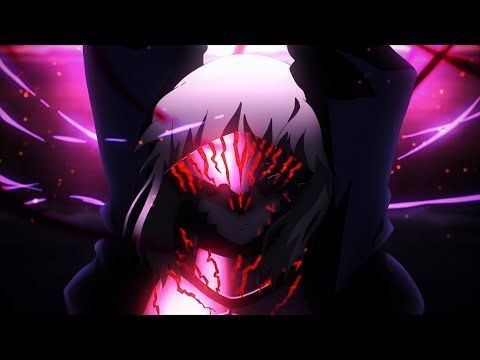

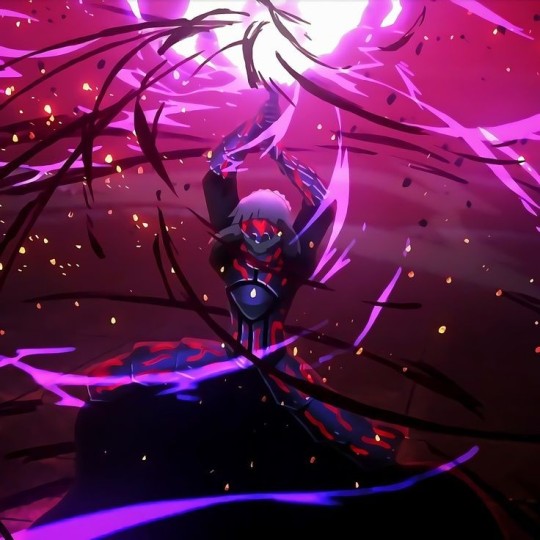




The vibe of blood vessels being exposed and pulsating, even on armor and clothes, like they're a part of Horaia's body itself. Not literal blood vessels but like. Looks close enough to be Creepy™. The armor is them and they're the beast the monster the killing machine on the battlefield, it's just another of the roles they play. Horaia already feels like they're acting out roles in hopes of not sticking out as inhuman among noble society (it's naaaaasty) so this time, why not lean into a role they'll fear out of spite? (In the sense of “oh you preach cruelty to me? you want cruelty? FINE I'LL GIVE YOU CRUELTY.”)
Like Hector who spooks his son because he was wearing a war helmet and it symbolizing how war makes monsters out of them all? Somewhat like that but entirely voluntarily.
Horaia, touching the face of her betrothed Ferdinand, the one whose hand in marriage they won in ditter after Magdalena ditched him (not out of romantic love, it's entirely platonic, both Ferdinand and Horaia in this AU being aroace, but a deep desperate sense of friendship, codependency, attachment, and duty), asking him “If I become something unforgivable, would you still love me?” and afterwards accepting Geduldh's (+chaos') blessings into their body to become That™. Corrosive, devouring magic, if you know the Shadow from Fate/Stay Night: Heaven's Feel? Yeah, that. The same effect that thing has on pretty much everything.

A drawing of Horaia as Zent, disheveled and bitter and resigned, to close this post off.
#ascendance of a bookworm#honzuki no gekokujou#horaia (oc)#horaia (aob oc)#Geduldh#Liminal AU#the god of dreams is also involved in this messy soup but I'm not getting into him the post is packed enough as is#Liminal: The Unstraying
28 notes
·
View notes
Note
Hello! I love the way you write the turtles!!
How would the turtles (separately) be like with a reader who loves mythology? Norse, Greek, Roman, etc. If reader gets asked a certain detail or story of a specific deity, reader starts smiling and rambling about it and the turtles just smile seeing reader like that! Can be headcanons or a one shot.
Have an awesome day!!
Turtle Brothers with an S/O Who's Really Into Ancient Mythos

Genre: Fluff
A/N: Thank you! Greek mythology was my hyperfixation for most of middle school, so this was hella relatable. Have a good day too!
Raph

He's SO excited that you have such a passionate love for old myths.
It gives him something to talk to you about, and seeing you smile so proudly about your extended knowledge makes him so happy.
His favorite myth is probably the World Tree from Norse mythology, and he's made you repeat the myth so many times.
It's like a toddler asking for the same bedtime story for an entire month.
He'll ask about every little detail, just to let you know that he's intrested.
Will take you to a museum and watch you spend from opening until closing talking about the significance of every myth, statue, painting, ect.
Michelangelo

Ngl, when you first started talking to him about mythologies, he was a bit bored.
Like, he's so happy you have some sort of interest, but he can never sit still long enough to hear you through.
Then you brought up the plays that people would put on to depict said myths.
And he was HOOKED.
Once every year you, him, and his brothers will put on a play for Splinter, April, and Casey.
His favorite so far is probably Medea from Greek Mythos.
He's so excited you two found a way to share your favorite intrest with him in a way that keeps him engaged.
Leonardo

Doesn't know a lot about myths, but he had a PJO phase, so he thinks he knows enough.
Then you pull out Aztec, Japanese, or Egyptian myths, and he's lost.
His favorite is definitely the Journey to the West. It's a long story with a lot of little mini myths, so you could tell him one Monster of the Week tale, and then tell him another one tomorrow.
It's what keeps him invested, he needs to know what happens next, and you guys did this for two years and counting.
If you end up going on a ramble that lasts hours, he's listening to every word, and the moment someone tries to tell you to quiet down or to stop, he's shutting them down before they get the chance.
HE wants to know about the Egyptian afterlife, thank you very much.
Donatello

Never particularly intrested in the myths themselves, but how they affected the society they were told through.
So you guys go back and forth on different myths and their impacts ect.
After a few weeks of this, he definitely got hyperfixated on this prospect. Would listen to mythology podcasts while working or study anicent civilizations when he's not training.
It should be concerning, but it's Donnie. When he's passionate about something, he gets passionate.
Stays up till the late hours of the night building a text-accurate replica of the Jade Palace with you.
Favorite myth is the Aztec creation myth.
#rottmnt x male reader#rottmnt x reader#donatello x male reader#donatello x reader#leonardo x male reader#leonardo x reader#raphael x male reader#raphael x reader#michelangelo x male reader#michelangelo x reader
281 notes
·
View notes
Text
Another odd thing about the way people present Aztec Mythology is the way Tezcatlipoca is the only one held responsible for anything that happens in the five suns legend. Oh no he destroyed a world, what a uniquely evil act in this mythology, oh wait, Quetzalcoatl destroyed the first world, where Tezcatlipoca was the sun.
Also the destruction of the third and fourth suns/worlds gets blamed entirely on Tezcatlipoca and not say Tlaloc making the choice to respond to his wife leaving him by making it rain fire and destroy the world. And if we're excusing Tlaloc for that, then Tezcatlipoca destroying Quetzalcoatl's sun is only fair after Quetzalcoatl destroyed his.
Not to mention in some variations worlds three and four are destroyed because Quetzalcoatl and Tezcatlipoca won't stop fighting, it's both of their fault. But then they make up to create the fifth one, and it's Tezcatlipoca who makes the sacrifice that ultimately gave us the earth we walk on.
And of course all of this is not even getting into that these are gods in a creation myth, not characters written for literary purposes. The first four worlds/suns had to be destroyed to make way for ours.
Tezcatlipoca and Quetzalcoatl exist in a cycle of creation and destruction where they're responsible for both, it just depends on the moment. Placing either in a binary unchanging role screws both of them up.
12 notes
·
View notes
Text
Deep dives into folklore: Mexican folklore
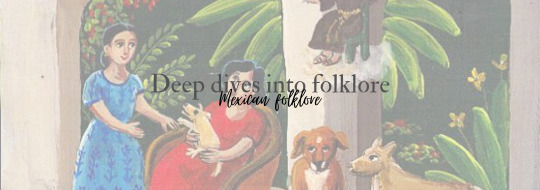
Within the vivid landscapes of Mexico, a captivating mosaic of folklore and mythology unfolds, echoing the voices of ancient civilizations and the whispers of colonial legacies. Mexican folklore, a vibrant narrative quilt, stitches together the threads of indigenous wisdom, Aztec myths, and the syncretic tales born during the Spanish conquest. In this exploration, we embark on a profound journey into the heart of Mexican folklore and mythology, unraveling the tales of gods and goddesses, mythical creatures, and timeless narratives that have woven a rich cultural tapestry throughout the annals of Mexican history.
Mexican folklore finds its roots in the pre-Columbian civilizations that flourished in the region, such as the Aztecs, Maya, and Zapotecs. The syncretism that occurred during the Spanish colonization further enriched the folklore by blending indigenous beliefs with Catholic traditions. This unique fusion gave rise to a diverse pantheon of deities, mythical creatures, and folk heroes, forming the foundation of Mexican folklore.
Aztec Pantheon:
Central to Mexican mythology is the Aztec pantheon, featuring deities like Quetzalcoatl, the feathered serpent, and Tlaloc, the god of rain. Myths surrounding the creation of the world, the struggles between gods, and the cyclical nature of life and death provide a rich backdrop to Mexican folklore.
La Llorona:
One of the most iconic figures in Mexican folklore is La Llorona, the weeping woman. Her haunting tale of love, betrayal, and maternal grief has been passed down through generations, resonating as a cautionary tale and capturing the imagination of storytellers and artists alike.
Nahualli and Nagual:
The concept of the nahual, an animal spirit guide, and its counterpart, the nagual, a human capable of transforming into an animal, reflects the deep connection between humans and the natural world. This belief persists in Mexican folklore, emphasizing the symbiotic relationship between the physical and spiritual realms.
Mexican folklore is not confined to the realm of ancient myths; it remains a living, breathing part of the culture. Festivals, celebrations, and religious rituals often incorporate elements of folklore, providing a link between the past and the present. Day of the Dead (Día de los Muertos) is a prime example, where families honor their ancestors and celebrate the continuity of life through a blend of indigenous and Catholic traditions.
Mexican folklore has profoundly influenced the arts, literature, and visual culture of the nation. Muralists like Diego Rivera and writers like Octavio Paz drew inspiration from the mythic past, infusing their works with the symbolic imagery and narratives of Mexican folklore. Contemporary artists, such as Frida Kahlo, continue to explore and reinterpret these mythic themes, contributing to the ongoing evolution of Mexican cultural identity.
In conclusion, Mexican folklore and mythology are indispensable facets of the nation's cultural identity, reflecting the resilience and creativity of a people shaped by diverse historical influences. From the ancient civilizations to the present day, these myths and tales continue to weave a narrative tapestry that resonates with the soul of Mexico. As the stories of gods, heroes, and spirits endure, they provide a timeless connection to the past and offer a source of inspiration for future generations, ensuring that the echoes of the ancestors will continue to reverberate through the cultural landscape of Mexico.
Taglist (reply or reblog to be added): @axl-ul @crow-flower @thoughts-fromthevoid @alderwoodbooks @harleyacoincidence @tuberosumtater @sonic-spade @theonlygardenia @holymzogynybatman @nulliel-tres @w0rkah0licz @sylvanthorn @tigertaurus22 @profiterole-reads @mathias-musings @1899adgg1997tbmd @grimmparanormalinvestigations
#writeblr#writers of tumblr#writing#bookish#booklr#fantasy books#creative writing#book blog#ya books#ya fantasy books#writers block#teen writer#writblr#tumblr writers#writerblr#writer problems#writers#writers community#writers corner#writers on tumblr#writerscommunity#writerslife#writing blog#writing community#mexican folklore#deep dives into folklore#folklore#myths#mythology
7 notes
·
View notes
Text
Pollux Codex
In this post I'm going to go reeeally in depth into Pollux's name and what it meant since the beginning.
I'll tackle both "meta" (symbolism, foreshadowing, etcetera) reasons and why Pollux himself would choose it ::)
Warning this is like a super super long post. I am insane.
Section 1: Who is Pollux?
It is necessary to know first and foremost who this lil guy is. I mean. I don't think anyone who isn't in "The Arts of Being"'s mini-fandom is going to wind up reading this,.. so I guess it'll be quick!
Pollux is a Hexagon who, back in Flatland, really loved history (and interestingly enough, eventually was to repeat it from the very beginning, tracing back to Flatland's 'Big bang') — His real name is Paul Schwarz, but he uses his codename, Pollux Codex, and has earned the title "The Hexed" post-TAoB.
Pollux became an Apostle of the Gospel of Higher Dimensions, supposed to enlighten his world along with Bill.
Section 2: Why did he choose the name?
Pollux chose the name because it is related to his main interests! Pollux is a character in Greek mythology (while greeks or their mythology may not exist exactly in Flatland, this is still important.. maybe he translated the name from that of an actual character of an ancient mythology and saw that it had the same attributes as the Pollux of Greek mythos so thats why he uses it in our language? idk give me a Break) and a codex is an ancient manuscript text, tied in to history and his love for reading.
Codex, with the x removed, is Code, like a secret code - reference to Bill's codename, Cipher.
Also, both Pollux and Codex have 'x' in them, and Pol REALLY loves how that letter sounds. ks. ks. ks. ks. Also loves the sound of 'k', but clicking doesn't have a lot of positive connotations according to Flatlanders.
And, of course, it sounds really cool, somewhat similar to his real name [fun fact: i did not realize that Paul and Pol are probably pronounced the same.. perks of not being a native english speaker] and goes along nicely with Bill Cipher.
Section 3: Pollux
On to the interesting part! The meaning behind the names.
Yes this section and everything below was written like 5 days after everything above lol.
Pollux in Greek Mythology is known, along with his twin brother Castor, as the gods (together called Dioscuri) of twins, horsemanship and sailors.
Pollux is immortal, whilst his twin Castor is a mortal. Castor is killed, and Pollux asks his father, who is a god, to share his immortality with his brother. Once turned immortal together, they both become stars, stars that sailors use to guide themselves at sea.
Twins
Twins and duality are a reocurring thing in both Gravity Falls and The Arts of Being. In Gravity Falls there are Dipper+Mabel, Stanford+Stanley, and there is discussion of an entity that is 'the opposite of Bill', in the fandom said to be either the Oracle or the Axolotl.
The twins theme is reinforced on accident by the interpretation of The Olden Days of Bill's last words, where people thought he was invoking Xolotl, aztec god of fire and lightning, twin of Quetzalcoatl, and also god of twins, illness, deformities, and monsters, but also an important part of the creation myth of the mythology. Quetzalcoatl, on the other hand, represents life, light, wind, rain, civilization and knowledge.
These two gods are also a great inspiration for what later on become the roles of Pollux and Bill in the new mythologies of the Exwhylians, Ypwherenians and Zetwhatians, is referenced through things like Bill's association with fire and Irregularity being important in his story, and Pollux's love for rain and later on how he became the foundation of the new civilizations.
and it's also a lovely reference to my homeland México ::3 !!!
In The Arts of Being, this twin situation is mirrored. Bill's father and uncle, Caesar William+Arrhenius William Campbell are twins. A. Square, author of Flatland, and B. Square are twins in TAoB. However Bill and Pollux themselves.. don't seem to have their own twins.
For Bill, either he has a twin that he does not know of, or his twin bond is with Liam, his adoptive older brother. He is very close to him, so who says they can't have the twin bond?
When it comes to Pollux, he actually had a twin. One that existed for little time. (Yet another thing I should add in the rewrite, because while it was always a thing I knew, I never really mentioned it and it bugs me). Basically, while in the womb he had a twin, one that early on merged with him. Had this not happened, Pollux would've been a pair of Pentagon boys instead of one Hexagon. Pollux himself sees his mind as 'two brothers trying their best to pilot one body'.
The twins of Gravity Falls are often seen as opposites, like Xolotl and Quetzalcoatl, Stanley and Stanford with the 'strong dumb' vs 'smart and shy' etc. Bill's father and uncle have a similar dynamic even down to their children - Caesar had an Irregular son and whatever the hell's going on with Bill, while Arrhenius had three perfectly regular and successful Square sons.
Bill and Pollux both become part of their duality through their close relationship, despite not being twins, they are undoubtedly sticking together forever after losing their 'counterparts'. Bill's the outgoing dream demon who lies just because he can, who's purpose becomes that of 'liberating' each dimension, while Pollux is the quieter dream angel - oneiraph - who only lied in an attempt to protect himself, eventually becoming the builder of the new Flatlands. There are more details, like their color pallette outside of Flatland, with Bill having a golden body and blue fire, while Pollux has a blue body with yellow fire, the associations with fire vs rain, etc.
Horsemanship and Sailors
Neither Pollux nor Bill have any interactions with horses, and the sea doesn't even exist in Flatland. How does this tie in to TAoB, too? Well, in a more symbolic way, just like how Bill and Pol themselves have no biological living twins.
Well I'm going to ignore the horsemanship part because. Yeah. But, as for the sailor part. Their sea is that of extradimensional knowledge.
Pollux and Castor, once turned into stars, are used as reference by sailors to guide themselves at sea. If you refuse to use any sort of guide while at sea, you are likely to get lost and eventually die.
Pollux and Bill 'become stars' as they ascend into what would be the sky if Flatlanders had one, when A. Shape and A. Sphere pull them three-dimensionally-upwards in order to turn them into their Apostles of Higher Dimensionality.
As 'stars' (Apostles), they are supposed to guide the Flatlanders to enlightenment - to survival. But ignored, ridiculed and imprisoned for this, Bill ends up accepting A. Shape's deal and liberating the dimension under the excuse that they had not allowed themselves to be guided.
Beyond Dead Flatland, they still are guides for those who follow them - those who seek chaos and destruction and fun follow Bill, and those who seek higher knowledge follow Pollux, Apostle of the Axolotl itself.
Section 4: Codex
Guys I'm starting to get tired of writing so much but I'm still hyped up. Excuse the decaying quality I am no longer talking about aztec/mexica gods.
Codex, an ancient manuscript, is a reference to the Book of Three Dimensions/the OG Flatland written by A. Square/Mr. Abbott (and Gravity Falls' Journals).
Codices are usually amongst the few things we have available to know about ancient cultures, their traditions, etcetera. Pollux in the end of The Arts of Being becomes a living codex of his own lost world, being the last person within Time and Space that knows of Bill's full origin and the old culture of Flatland, along with being the one to build history of several dimensions afterwards.
Pollux as the Apostle of the Axolotl isn't only restricted to the Second Dimensional Worlds, but he also learns of many, many worlds and dimensions beyond them, becoming one of the wisest and most ancient creatures of Timespace.
Section 5: The Hexed
Pollux earns this title thousands of years after The Arts of Being, a title that has an unknown origin in universe, whispered in awe across dimensions.
"The Hexed" is, first and foremost.. a pun. Hexed. Hex. Hexagon. he is a hexagon. euehehehehehhe im so sorry.
A hex is sort of like a curse. Pollux feels cursed, hexed - he survived the death of his entire universe, but he suffers. Everyone he ever knew, every book he ever read, each and every single innocent person died, and he feels responsible for it, and it haunts him.
He hopes that Bill can be redeemed, that he really will return to the Axolotl, but his hope is stretching very thin as millions of years pass by and Pollux is still there, painfully remembering everything.
And he also feels horrible for yearning for Bill so badly because he knows, he's completely aware that Bill isn't out there spreading love and kindness in the multiverse, he knows he causes suffering just for funsies and he hates himself for wanting to give him a second chance after all that has happened, and at the same time, feels ungrateful for wanting to undo his destruction, because that would also imply the destruction of his dear Exwhylia, Ypwherenia, Zetwhatia, of undoing all the good deeds he's done as an angel, of never giving Providence and Nature the relief of knowing that the descendants of their world are in good vertices.
21 notes
·
View notes
Text
That time a YA Series crossed over with Doctor Who, and know we have solutions to who the Other, Yssgaroth, and Enemy are (2013) [Mimir Canon-Weld]
I was on the Doctor Who Discord Server (in the "canon-welding" channel) and @aristidetwain mentioned a short story called "The Nameless City", which was a crossover between Doctor Who and Michael Scott's Secrets of the Immortal Nicholas Flamel . Me and Ryan Fogarty then proceeded to Canon-Weld to regeneration.
This crossover featured the Archons from Scott's series, of which none are named in this crossover short, but in Scott's series three were named: Cernunnus, Coatlicue, and Mimir.
Cernunnus can obviously be can-welded to being @doctornolonger 's creation, Cernunnus the leader of the (original?) Mammoths.
Coatlicue was, within Scott's series, a scientist that turned herself into a monstrosity. According to the TARDIS wiki's "Behind the Scenes" section on the article "Archons (The Nameless City)", she is the "snake-like progenitor of all vampires", although I could not find any source for either the real-life Aztec god nor Scott's creation being either of these. If this were to be true, it allows for an obvious canon-weld with the King Vampires of the Yssgaroth.
"Out of her own DNA she created the original blood drinkers, who would eventually become your race. Coatlicue was the first vampire"
Now we come to Mimir, where things get crazy. In Norse myth, and in Scott's series, Mimir is mentioned to have "given knowledge to Odin". Of course, in my canon-welding mind, I see that literally any Head of the Gods is Rassilon Urizen the Architect. Who else is mentioned to have given Rassilon knowledge? The Other (PROSE: Lungbarrow). Hence, Mimir is the Other. This also fits with the "ancient being" origin for the Other. This means that the Great Houses were helped in development by a species that contained at least two notable members who would eventually become their worst enemies (Coatlicue/Yssgaroth and Cernnunos/The Enemy). The original short story The Nameless City says that the Archons created the seeds for the TARDISs timeships, and that Rassilon Urizen stole the seeds in a great war. This war, presumably, happened before the First War in Heaven / Yssgaroth War, due to the fact that the Great Houses do have timeships in that war. This also gives another motivator for the Yssgaroth in their War besides the Child-That-Was-Taken. The Archons are also mentioned to be the "last of the Old Ones, from the universe before this", but I normally interpret the "universe before this" to refer to the "time before this", i.e. the unachored universe. They also still have a homeworld, the titular Nameless City with the Great Desolation (presumably positioned outside normal spacetime, and I think the main Spiral Politic).
In conclusion, this canon-weld has resulted in a revised timeline (in my personal canon):
Before anything and everything
The Great Old Ones exist somehow.
Most of the Great Old Ones die off, or potentially construct their own Spirals, totally disconnected to the eventual Spiral Politic.
The shobogans are born on the planet Gallifrey
A group of the last Great Old Ones come together as the "Archons"
An order reminiscent of what the Great Houses will be are formed, and the Pythian Order leave Gallifrey (some going to the nearby planet Karn)
The Almost-Great Houses wage many wars against the peoples of the universe, especially the Archons.
Cernunnus creates many "mammoth empires" across the universe
Mimir, in an attempt to stop this devastating War, joins Urizen by his side, only to be remembered simply as "the other"
With the knowledge Mimir had granted him, Odin Urizen finally stole the timeship seeds the Archons had been growing, forcing them to surrender.
The Archons retreat to their own semi-anchored reality, the Great Desolation. Coatlicue presumably creates her own Spiral soon after this, spawning the Yssgaroth.
Tecteun discovers the Child-That-Was-Taken/Timeless Child under a "rift" (in reality one of the early anchors for the Anchoring of the Thread project, already being executed by Urizen). The other side of this rift could be presumed to be the Spiral Yssgaroth.
The Great Houses execute the Anchoring of the Thread, which immediately summons Coatlicue (the King Vampire) to their Homeworld, creating the caldera. The Yssgaroth War begins.
Blah blah blah Pre-War era, blah blah blah the War happens
#faction paradox#doctor who#great houses#gallifrey#the Nameless City#secrets of the immortal nicholas flamel#canon welding#timeline#yssgaroth#canon-welding
59 notes
·
View notes
Text
Concept: the Alien Legendarium
We (the people in the Humans are Weird fandom) have touched on humans love of story and storytelling despite medium, but what I don't think we've really gone into is just how much.
And especially stories from other cultures. Every kid I knew growing up went through a(t least) a phase of obsession over different mythologies. I myself have a deep love of all fairytales.
So, maybe Aliens would be surprised at how much we love stories and how many stories we tell and retell, especially to them. What if other alien cultures didn't share their stories? Their histories, sure, that's necessary for politics and stuff, but what if they never thought to be interested in each other's myths or religions.
We all know that would never fly with humans. The first time someone caught a whiff of a culture's founding myth or creation story there would be at least a small, dedicated group of humans ready to ferret out every version they could get their little raccoon hands on.
Even more interesting if an alien culture doesn't seem to have any myths, legends, or urban legends. I honestly can't imagine a society without things like local ghost stories or religious conspiracy theories, so seeing one, or at least one that appears to not have any of those things, would be fascinating.
Of course, my definition of legend is very broad, so, for instance, it would be incredibly funny for an alien to come up against some of the common social myths. (The first alien to take an exam with a bunch of humans and hear "Y'know that if someone dies during an exam, everyone else gets an A. So, who's takin' one for the team?" definitely almost has a heart attack.) And, and! the aliens know that plenty of humans are alien/monster fuckers, but they're absolutely flabbergasted at the idea that the humans want to fuck their monsters??? Like, the ones from their mythologies??? How did you even know what a Xin'krakx is much less what it looks like?
I'm digressing a bit. Think of how strange humans would seem though, if aliens suddenly had to figure out how to deal with converts to their religions? They go out to see a movie and it's a human retelling of their creation myth that most of them barely know, so how did the human know about it?
And then! The aliens start hearing their own stories, songs written about their folk heroes and legendary kings, seeing artwork and religious writings hundreds of light years away from their home. How did it get there? The humans liked it. Your culture's creation myth is now written down in this beautifully illuminated and hand bound leather tome in both a human language and your native language.
Imagine the confusion.
Imagine the culture clash.
Imagine the space sjws who are convinced that making a short film based on a myth from an alien culture is appropriative, despite the people from the culture in question having no problem with it other than being perplexed at why the humans care about heroes that aren't human or otherwise from earth and from their own stories.
And of course, humans being humans, we would do what we do and collect all of these myths in one place. I can imagine that each alien culture would have at least one volume of legends translated into a human language each that are constantly getting new additions when the researchers resurface. The Aarne-Thompson-Uther multilingual folktale database expands rapidly as well as any cryptid compendiums. Children start going through Andromeda-6 and Corscal-14 mythology phases as well as greek or egyptian or japanese or aztec.
And we do what we also do, and we mix up those stories. We retell them and mash them together regardless of cultural origin. We tell them and retell them and many of us dedicate our lives to studying and learning about them and what they can tell us about the perceptions of the early culture and their values and experiences.
Idk, I just think it'd be interesting.
#humans are weird#humans being humans#I'm talking about those (primarily) white people who think that only people from a culture should be able to tell those stories#which is incredibly funny to me#especially if it's something like a morality fable#sorry. you can't write about the Jersey Devil because you aren't from New Jersey#I just imagine what it would feel like if some alien came down from space and started gushing about. like. Arthurian legends
15 notes
·
View notes
Text
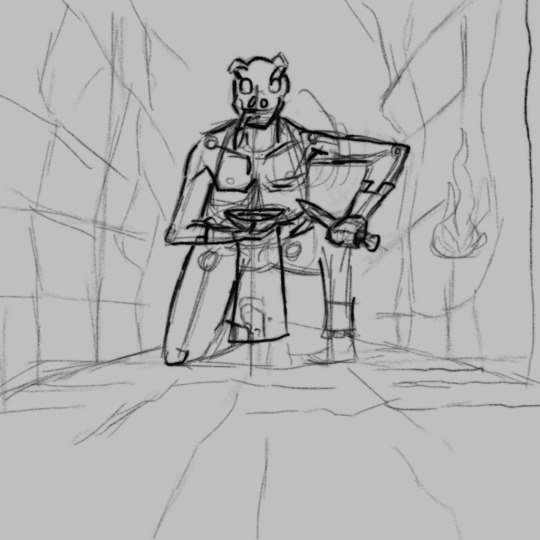
A sketch of Xolotl, Aztec god of fire, lightning, monsters, and a guide of the dead, offering the viewer his blood in a bowl.
Religious bloodletting was common in Mesoamerica. In the religion of the Aztecs (or more accurately, Mexica) it was believed that the gods sacrificed themselves in the creation of humanity and the world. Xolotl played a particularly important role in this, as depending on the version of the myth of the fifth sun he either alone or assisting his brother Quetzalcoatl gave humanity life, by sprinkling his blood on the bones the previous humans who had gone extinct.
In the view of the Mexica, and many other Mesoamerican cultures, it was believed that everyone has divine essence within them due to legends like these. So when human blood was sacrificed, either through bloodletting or human sacrifice, it was returning the favor to the gods.
With the artwork itself I've tried using Krita again after using GIMP and mspaint for a while. I think I've achieved better results with GIMP. I posted this sketch as figuring out coloring has been a little more difficult. Because I'm using simpler methods with GIMP I have a better idea of the workflow and find it easier to finish my works. With Krita I've had trouble getting the edges to how I want them as I'm going for a proper painting look rather than line art. (Though I seem to do better with line art)
Also, Xolotl had no dedicated temples nor priests. Most worship of Xolotl was leaving offerings in the forms of artwork. And I just made some. Hmm.
#xolotl#my art#krita artwork#bloodletting#cw blood#aztec mythology#mesoamerican mythology#aztec religon#mesoamerican religon
5 notes
·
View notes
Text

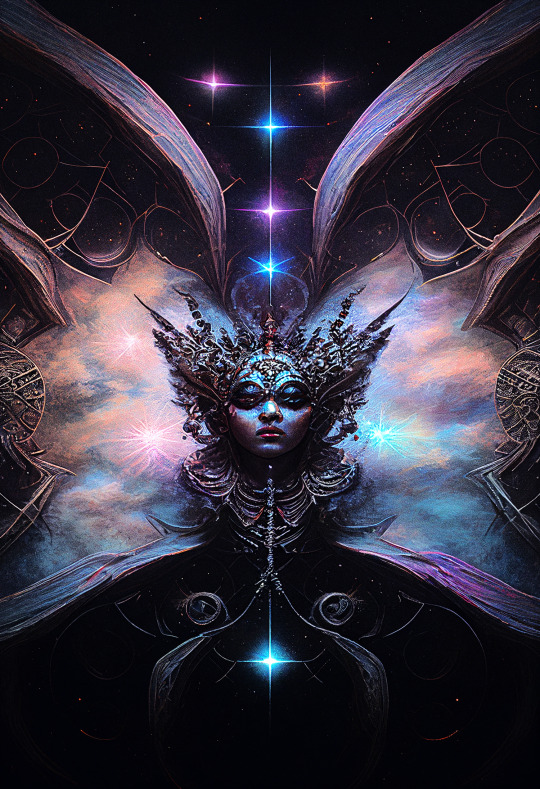
The Creation Myth of Itzpapalotl
According to Aztec mythology, Itzpapalotl's origins are intertwined with the celestial realm. One legend tells of her transformation from a beautiful celestial butterfly to a fearsome warrior goddess after a catastrophic event that resulted in the fall of the Fourth Sun. Her metamorphosis symbolized the cyclical nature of life, death, and rebirth, and her dual nature as both a serene butterfly and a fierce warrior.
Obsidian Butterfly : Mahaboka
7 notes
·
View notes
Text
According to the Aztecs, the world has been created and destroyed four times already, and will be destroyed again. Are we living in the world of the Fifth Sun?
45 notes
·
View notes
Text
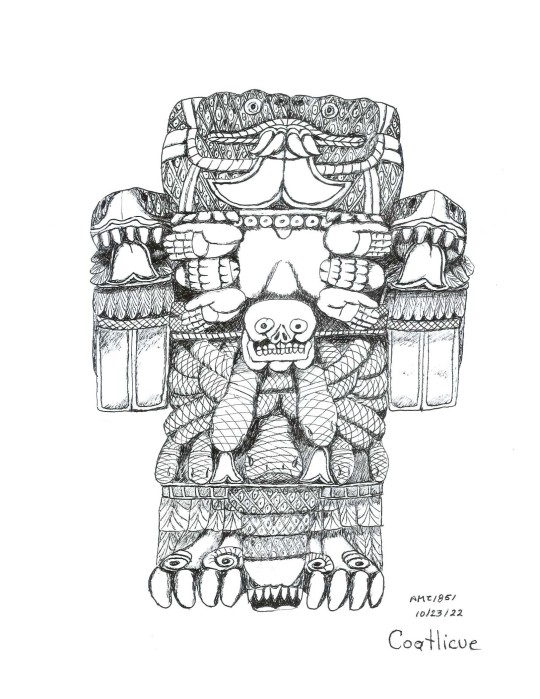
Coatlicue
To celebrate the Day of the Dead in Mexico, I made a drawing of the Aztec Mother of the gods Coatlicue, Goddess of fertility, patroness of life and death, guide of rebirth. Coatlicue is represented as a woman wearing a skirt of writhing snakes and a necklace made of human hearts, hands, and skulls. Her feet and hands are adorned with claws and her breasts are depicted as hanging flaccid from pregnancy. Her face is formed by two facing serpents (after her head was cut off and the blood spurt forth from her neck in the form of two gigantic serpents),referring to the myth that she was sacrificed during the beginning of the present creation.
7 notes
·
View notes
Note
Happy STS! What gods from our world's myths would you assign to your characters? Who would fit the best to your character and why?
Happy STS, Pheita!
Congrats, you've unlocked an info dump! 🎉 And for this we're going to visit the Aztec Pantheon.
Mariel
The Lord of Fire and God of Time, Xiuhtecuhtli. I can't explain this one too much bc spoilers but here, have this! And know, it's super accurate for her and her arc!
In historical sources he is called by many names, which reflect his varied aspects and dwellings in the three parts of the cosmos. He was the lord of volcanoes, the personification of life after death, warmth in cold (fire), light in darkness and food during famine. He was also named Cuezaltzin ("flame") and Ixcozauhqui and is sometimes considered to be the same as Huehueteotl ("Old God"), although Xiuhtecuhtli is usually shown as a young deity.
Axtapor
God of Providence, The Invisible and Darkness, Lord of the Night, Tezcatlipoca. This seems off base for him unless you've read the books. So, if you know, you know.
Obsidian mirrors were used ritually to spiritually access the Aztec underworld and communicate with the realm of the dead. The name of the important Aztec deity Tezcatlipoca means "Smoking Mirror" and he was apparently the supernatural embodiment of a polished obsidian mirror. Depictions of the god frequently replace one of his feet with a smoking mirror and position another at the back of his head.
Fay
Goddess of Water, Mistress of Lakes, Rivers and Seas, Chalchiuhtlicue. There is just so much that Fay and this goddess have in common, that its hard not to relate them, these bits in particular are striking:
According to myths, Chalchiuhtlicue once ate the sun and the moon. She is often associated with serpents, as most Aztec water deities are. It is thought that her association with water and fertility speaks to the Aztecs' association with the womb and water. She often withheld a dual role in Aztec mythology as both a life-giver and life-ender. In the Aztec creation myth of the Five Suns, Chalchiuhtlicue presided over the Fourth Sun or the fourth creation of the world. It is believed that Chalchiuhtlicue retaliated against Tlaloc's mistreatment of her by releasing 52 years of rain, causing a giant flood which caused the Fourth Sun to be destroyed.
Wilkes
The God of War, Lord of the Sun and Fire, Huītzilōpōchtli. I previously answered here that this god would be his father, but I think as the story has progressed, Wilkes himself would fit this god best. Here is the snippet of Huitzilopochtli's creation myth that is PERFECT for Wilkes:
Huitzilopochtli burst forth from his mother's womb in full armor and fully grown, or in other versions of the story, burst forth from the womb and immediately put on his gear. He attacked his older brothers and sister, defending his mother by beheading his sister and casting her body from the mountain top. He also chased after his brothers, who fled from him and became scattered all over the sky.
Lexlar (Quye'ck) and Hartim (Eiph'ck)
Gotta be the twin Gods Quetzalcoatl and Xototl. There is so much here with these two that its hard to sum it up in a concise way, but in many legends they are believed to be the morning and evening stars respectively, with the latter (Xototl) being entrusted with guiding the Sun through the Underworld and acting as a soul guide for the dead. Meanwhile Quetzalcoatl represents death and resurrection and in some tellings was banished... Iguanas and serpents also hold special meaning and symbolism in Mayan and Aztec mythology, as connections between the earth and spirit realms as well being vehicles by which celestial bodies travel the world. They got away from me in the best way 💙
6 notes
·
View notes
Text
Rules: Share your OC's full name and the meaning/origins behind it. Then (If you'd like) inculde any insights or symbolic meanings about their name you wish to share, or just your reasons for giving them the name that you did!
No pressure tags: @zablife @raincoffeeandfandoms @call-sign-shark @thegreatdragonfruta @red-riding-wood @runnning-outof-time @arcielee @assortedseaglass
Eva Leonor Smith Riley
Cw: use of a slur, mentions of suicide
For oc names i go with how the parents would name them given the society they live in and vibe. Eva was no different.
Eva gets two lastnames because of naming conventions in mexico, so its her father's surname followed by mother's maiden name.
So first name and middle name:
Eva: is the latin spelling of the hebrew words Chava/Hava meaning life or life giver.
While i could lie and say Eva’s name was chosen of the symbolism that she helps Tommy heal and grow into a better man, she is named Eva after Evita Peron, first lady of Argentina who after her dictator husband was overthrown.
She was rather influentian and there was a myth taht where her body was hidden(it was exhumed and stolen) flowers would appear there.
Eva's name also comes from a 1917 femme fatale played by Mimi Derba in La Tigeresa named Eva who pretended to be a poor woman to win the heart of a lower class man and then broke up with him, faked her death which drove him insane only for her (now married to a rich man) to visit the institution he was in for charity and he kills her in his mad rage.
While the femme fatale is more in line with s1 Grace , Eva reveals in Of Gods and Witches she seduced the president's son and when he discovered his father was gonna have her assassinated while under house arrest he commits suicide ala Antigone and Haemon. This all happened while she was secretly dating her best friend and cousin’s secret girlfriend, Antonia.
But in the fic, Eva is named Eva because her mother, Isabel, schemed to make herself go into labor in the Sistine Chapel(right ubder God's Creation of Eve)to get the current Pope (Benedict XV) attend the baptism and his successor the future Pope Pius XI to be her godfather because the archbishop of mexico refused to go to her family's estate to baptize Eva’s older brother Gabriel.
Leonor: is the portuguese and spanish variant of Eleanor meaning Torch, light and/or sun ray.
Leonor was the name of her great grandmother who descends from Emperor Moctezuma, the last Aztec ruler, through his son Juan Moctezuma who was made a spanish noble. Leonor Moctezuma, Eva’s great grandmother, was born to a member of the Moctezuma family and a Nahua secretary in Mexico City.
Last Names:
Smith: anglo-saxon 'to hit or strike' possibly related to a person who was a metal worker.
So Smith is a common English surname and the surname of a romani traveller king named Absalom Smith in the early 19th century. He died in 1826 with the title of king of the gypsies (please excuse the slur)and had been elected so in the early 19th century according to the Mamchester Times. He was a fiddler and his daughter Beatte Smith was so beautiful there is portrait of her in Belvoir Castle, Manchester.
The Smiths were apparently an important Romani family like the Boswells who the Shelbys claim descendance from and the Welsh Romani woman Tommy seeks to see if the sapphire was cursed is also a Boswell. Eva was originally going to be a Boswell but that would've made her a relative of Tommy and i decided against it.
Riley: anglicized irish last name meaning rye-clearing.
So Eva’s grandfather Patrick Riley was an Irish immigrant and oc nephew to John Patrick Riley, Captain of the Saint Patrick's Battalion who were composed Catholic Irish, Scotsmen. Freed slaves and men of color tired of the racism they dealt with in the US and defected to Mexico right before the Mexican American War in the 1850s.
John Riley immigrated to the US due to the Great Famine and despute being known for his great strength of character and morality died alone and penniless in Veracruz as the torture and defeat of his battalion at the hands of the americans left him with very severe trauma and teh letters D on both sides of his face branded onto his skin for desertion even though he deserted before the war.
It provides as to why Eva is of mixed race and how her grandmother who is old money ended up having red haired children and show how diverse Mexico actually is
3 notes
·
View notes